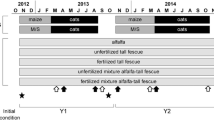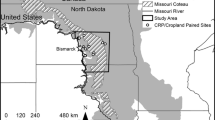ABSTRACT
We examined the distribution of soil organic carbon (SOC) fractions and roots with depth to improve our understanding of belowground carbon dynamics in the shortgrass steppe of northern Colorado. Weaver and others (1935) found that the surface 15 cm of soil contained over 70% of the total roots found in a tallgrass prairie soil profile, while only accounting for 40% of the profile soil organic matter. We asked whether the relationship between roots and SOC that Weaver and others (1935) found in the tallgrass prairie was also found in the shortgrass steppe. Weaver and others (1935) suggested that the dissimilarity between belowground biomass and SOC with depth is the result of variability in decomposition rates. In an effort to determine whether patterns of SOC are the result of short-term plant input patterns or decomposition, we measured the 14C content of potentially mineralizable C and particulate organic matter (POM) C ten years after pulse labeling shortgrass steppe vegetation. We also estimated the mass specific decomposition rate constant (kPOM) for POM C through a shortgrass steppe soil profile. We found that the distribution of roots and SOM in the shortgrass steppe were similar to those observed in tallgrass prairie (Weaver and others 1935), with a higher proportion of total root biomass in the surface soils than total soil organic matter. Fifty-seven percent of root biomass was found in the surface 15-cm, while this same soil layer contained 23 percent of profile soil organic C. We measured the highest accumulation of 14C at the soil surface (12.0 ng 14C·m-2·cm-1 depth), with the least accumulation from 75-100 cm (0.724 ng 14C·m-2·cm-1 depth). The highest values of potentially mineralizable C were at the soil surface, with no significant differences in total mineralizable C among the 10-100 cm soil depths. The contribution of POM C to total C reached a profile minimum at the 15-20 cm depth increment, with profile maxima in the surface 5 cm and from 75-100 cm. We estimated that the proportion of particulate organic matter lost annually (kPOM) reached a profile maximum of 0.097 yr-1 within the 10-15 cm depth increment. The 75-100 cm depth increment had the lowest kPOM value at 0.058 yr-1. Thus, within the same physical fraction of SOC, decomposition rates vary with depth by nearly twofold. This pattern of high decomposition rates from 10-15 cm with lower decomposition rates at the soil surface and deeper in the soil profile may be the result of higher water availability in sub-surface soils in the shortgrass steppe.
Similar content being viewed by others
Author information
Authors and Affiliations
Rights and permissions
About this article
Cite this article
Gill, R., Burke, I., Milchunas, D. et al. Relationship Between Root Biomass and Soil Organic Matter Pools in the Shortgrass Steppe of Eastern Colorado. Ecosystems 2, 226–236 (1999). https://doi.org/10.1007/s100219900070
Issue Date:
DOI: https://doi.org/10.1007/s100219900070




